Submitted:
02 October 2024
Posted:
03 October 2024
You are already at the latest version
Abstract
Keywords:
1. Introduction
- Low and mid vowels evoke a sense of brightness, peace and serenity;
- High, front and back vowels evoke a sense of surprise, seriousness, rigor and gravity;
- Obstruent and unvoiced consonants evoke a sense of harshness and severity;
- Sonorant and continuant consonants evoke a sense of pleasure, softness and lightness.
1.1. State of Art in the Association of Sound and Meaning in Poetry
- Low, middle, high-front, high-back
- Obstruents (plosives, affricates), continuants (fricatives), sonorants (liquids, vibrants, approximants)
- Voiced vs. unvoiced.
2. Materials and Methods
2.1. How the ASSH Works: Dimensions and Parameters
- -
- Poetic Rhetoric Devices;
- -
- Metrical Length;
- -
- Semantic Density;
- -
- Prosodic Structure Dispersion;
- -
- Deep Conceptual Index;
- -
- Rhyming Scheme Comparison.
2.2. Semantic and Conceptual Parameters
- -
- easy to understand are those semantic structures which contain a proposition, made of a main predicate and its arguments
- -
- difficult to understand are on the contrary semantic structures which are filled with nominal expressions, used to reinforce a concept and as such they are simply juxtaposed in a sequence
- -
- also difficult to understand are sequences of adjectives and nominals used as modifiers, union of such items with a dash
- -
- in the definition of semantic parameters presence of negation and modality contributes to increase complexity, for this reason we compute Polarity and Factuality at propositional level.
- -
- the ratio of number of words vs number of verbs;
- -
- the ratio of number of verbal compounds vs non-verbal ones;
- -
- the internal composition of non-verbal chunks:
- -
- every additional content word increases their weight (functional words are not counted);
- -
- the number of semantic classes.
- -
- verbs found by the total number of tokens (the more the best);
- -
- adjectives found by the total number of tokens (the more the worst);
- -
- verb structures by the total number of chunks (the more the best);
- -
- inflected vs uninflected verbal compounds (the more the best);
- -
- nominal chunks rich in components: those that have more than 3 members (the more the worst);
- -
- semantically rich (with less semantic categories) words by the total number of lemmas (the more the worst);
- -
- rare words (the more the worst)4;
- -
- generic or collective referred concepts (the more the best);
- -
- specific vs ambiguous semantic concepts (those classified with more than two senses on the basis of WordNet) (the more the worst);
- -
- doubt and modal verbs, and propositional level negation (the more the worst);
- -
- abstract and eventive words vs concrete concepts (the more the worst);
- -
- we compute ATF based sentiment analysis with a count of negative polarity items (the more the worst).
2.3. Poetic and Prosodic Parameters
- -
- a count of metrical feet and its distribution in the poem;
- -
- a count of rhyming devices and their distribution in the poem;
- -
- a count of prosodic evaluation based on durational values and their distribution.
3. Results
3.1. Multidimensional Visualization Commented
4. Producing a Gold Standard Annotation for Satire Interpretation
4.1. Irony and the ASSH
4.2. Sarcasm and the ASSH
4.3. Neutral Sonnets and the ASSH
5. Discussion
6. Conclusion
Supplementary Materials
Author Contributions
Institutional Review Board Statement
Informed Consent Statement
Data Availability Statement
Conflicts of Interest
Appendix A







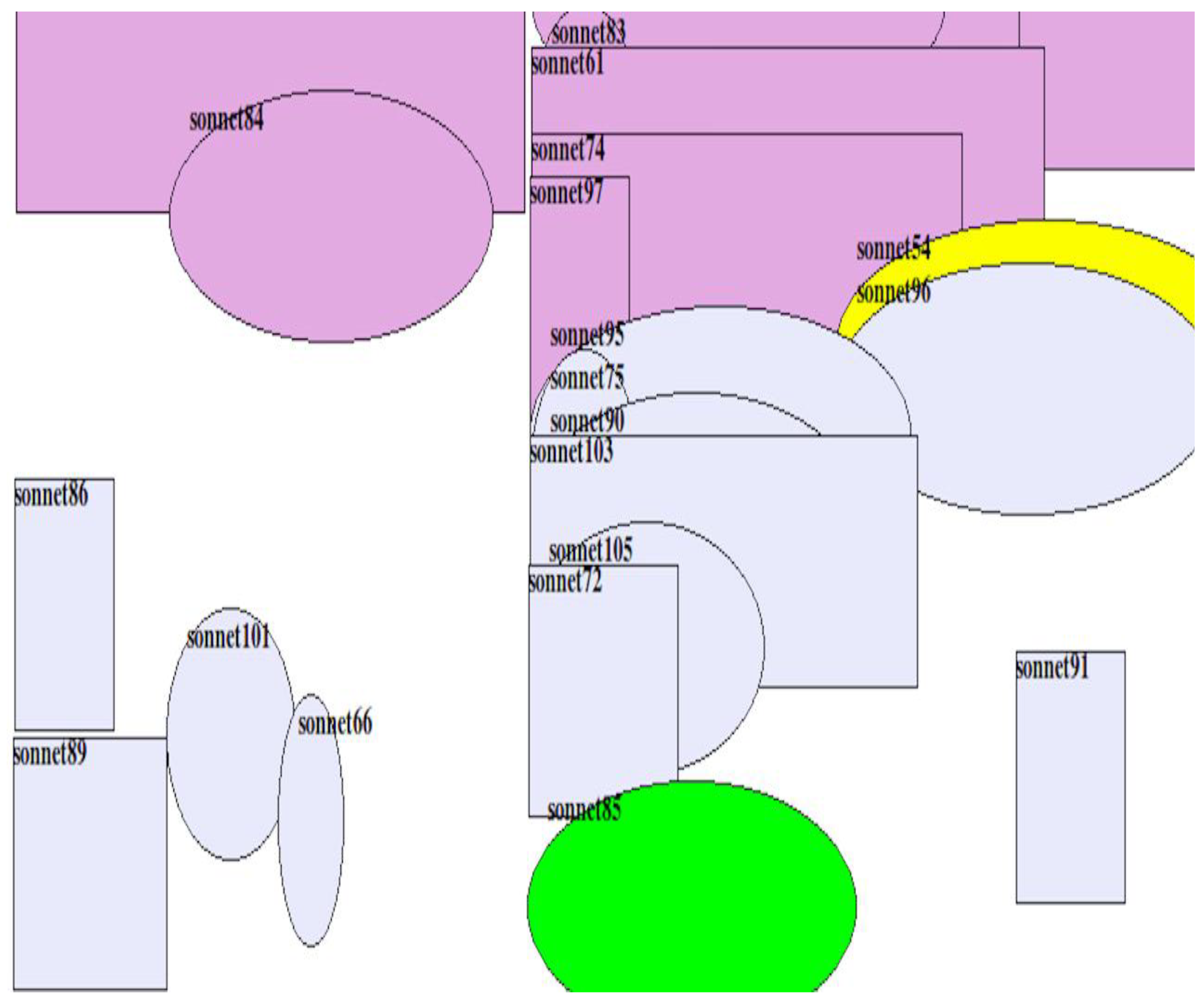




| 1 | The theory is organized around three subsystems, Engagement, Graduation and Attitude. We chose to select Attitude for our annotation guideline. The Attitude subsystem describes the author’s feelings and intentions as they are conveyed within the text, and it is articulated into three main semantic regions or subclasses with their relative positive/negative polarity, namely: Affect, Judgement, Appreciation. More in this section below. |
| 2 | Weiser dedicates his papers to comment on the Sonnets from the point of view of the irony they contain. As a literary critic, he refers to a number of previous studies by other famous literary critics like Stephen Booth, Harold Bloom etc. who also regarded the sonnets highly ironic. The number of sonnets judged as such are all included in the list that we discuss in the sections below.. |
| 3 | For a different approach to irony and satire detection see [26, 27] |
| 4 | To tell whether a word belongs to the list of rare words we use a number of dictionaries of word-forms freely available to download. We classify rare words as those with a frequency value lower and equal to 3 occurrences. |
| 5 | In more detail the RID and its internal organization. RID has some 3200 so-called search patterns, which are roots and words as entries and they are so divided: 1800 belong to primary concepts, 728 to secondary concepts, 616 to emotions. |
| 6 | We also use the list of word-forms divided into syllables freely made available as CMU Pronouncing Dictionary at the same website. |
| 7 | We checked our analysis mainly with Melchiori [30] and Schoenfeld [31] |
References
- Rodolfo Delmonte. Computing the Sound-Sense Harmony - a Case Study of William Shakespeare’s Sonnets and Francis Webb’s Most Popular Poems, Information, 2023; 14(10):576, . [CrossRef]
- Rimbaud, Arthur, 1871. Voyelles, 38th poem of the collection Poésies, Lutèce, Paris, 1883.
- Jakobson, R. Six lectures on sound and meaning (Trans.: J. Mepham). Cambridge: MIT Press; 1978, (Original work published in 1976).
- Jakobson, R., & Waugh, L. The sound shape of language. Bloomington: Indiana University Press; 1978.
- Mazzeo, M. Les voyelles colorées: Saussure et la synesthésie. Cahiers Ferdinand de Saussure; 2004; 57, pp. 129–143.
- Fónagy, Iván The Functions of Vocal Style", in Seymour Chatman (ed.), Literary Style: A Symposium. London: Oxford UP; 1971, pp. 159-174.
- Mallarmé, Stéphane, 1897, Crise de Vers, in Eugene Pasquelle, Divagations, pp. 235-251.
- Macdermott M.M. Vowel Sounds in Poetry: Their Music and Tone Colour, Psyche Monographs, No.13, London: Kegan Paul; 1940. [CrossRef]
- Tsur, Reuven. What Makes Sound Patterns Expressive: The Poetic Mode of Speech-Perception. Durham N. C.: Duke UP; 1992.
- Tsur Reuven, Poetic Rhythm: Structure and Performance: An Empirical Study in Cognitive Poetics; Sussex Academic Press; 2012, pp. 472.
- Genette, Gérard, 1976. Mymologiques, Voyage en Cratylie, Le Seuil, Paris. Mymologics – English Edition, 1995, University of Nebraska.
- Bolinger, Dwight, 1949, The sign is not arbitrary. THESAURUS, Tomo V., No. 1,2,3, pag.52-62.
- Busetto N.,Delmonte R., (2019b), Annotating Shakespeare's Sonnets with Appraisal Theory to Detect Irony, in Proceedings of the Sixth Italian Conference on Computational Linguistic, Bari, Italy, November 13-15, downloadable at http://ceur-ws.org/Vol-2481/paper11.pdf.
- Delmonte, R., & Busetto, N. (2019a), Detecting irony in Shakespeare’s sonnets with SPARSAR. In Proceedings of the sixth italian conference on computational linguistics; 2019. Available online: https://dblp.org/rec/bib/conf/clic-it/DelmonteB19.
- J. Martin and P.R. White. Language of Evaluation, Appraisal in English. Palgrave Macmillan, London and New York; 2005.
- M. Taboada and J. Grieve. Analyzing appraisal automatically. In Proceedings of the AAAI Spring Symposium on Exploring Attitude and Affect in Text: Theories and Applications; AAAI Press; 2004, pp. 158–161.
- David K. Weiser. (1983). The ’sonnets’. 84(4):456–469. Shakespearean irony: Neuphilologische Mitteilungen,.
- David K. Weiser. (1987). Mind in Character – Shake- speare’s Speaker in the Sonnets. The University of Missouri Press.
- Burfoot, C., & Baldwin, T. (2009). Automatic satire detection: are you having a laugh? Proceedings of the ACL-IJCNLP 2009 Conference Short Papers (pp. 161--164). Suntec, Singapore: Association for Computational Linguistics.
- Carvalho, P., Sarmento, L., Silva, M., & de Oliveira, E. (2009). Clues for detecting irony in user- generated contents: oh...!! it's so easy;-). Proceeding of the 1st international CIKM workshop on Topic-sentiment analysis for mass opinion (pp. 53-56). Hong Kong: ACM. [CrossRef]
- Reyes, A., & Rosso, P. (2011). Mining subjective knowledge from customer reviews: a specific case of irony detection. WASSA '11 Proceedings of the 2nd Workshop on Computational Approaches to Subjectivity and Sentiment Analysis (pp. 118-124). Stroudsburg, PA, USA: Association for Computational Linguistics.
- Owais, S., Nafis, T., & Khanna, S. (2015). An Improved Method for Detection of Satire from User- Generated Content. International Journal of Computer Science and Information Technologies, Vol. 6 (3), pp. 2084-2088.
- Gianti, A., Bosco, C., Patti, V., Bolioli, A., & Di Caro, L. (2012). Annotating Irony in a Novel Italian Corpus for Sentiment Analysis. In L. Devillers, B. Schuller, A. Batliner, P. Rosso, E. Douglas- Cowie, R. Cowie, & C. Pelachaud (Ed.), Proc. of the 4th International Workshop on Corpora for Research on Emotion Sentiment & Social Signals (ES3@LREC'12) (pp. 1-7). Istanbul, Turkey: ELRA.
- Hernandez Farias, D., Sulis, E., Patti, V., Ruffo, G., & Bosco, C. (2015). ValenTo: Sentiment Analysis of Figurative Language Tweets with Irony and Sarcasm. Proceedings of the 9th International Workshop on Semantic Evaluation (SemEval 2015) (pp. 694-698). Denver, Colorado, USA: Association for Computational Linguistics. [CrossRef]
- Özdemir, C., & Bergler, S. (2015). CLaC-SentiPipe: SemEval2015 Subtasks 10 B,E, and Task 11. Proceedings of the 9th International Workshop on Semantic Evaluation (SemEval 2015), (pp. 479-485). Denver, Colorado: Association for Computational Linguistics. [CrossRef]
- Kim, S.-M. and E. Hovy (2004). Determining the sentiment of opinions. In Proceedings of the 20th international conference on computational linguistics - COLING, Stroudsburg, PA, USA, pp. 1367–1373. ACL.
- Kao Justine and Dan Jurafsky. A Computational Analysis of Style, Affect, and Imagery in Contemporary Poetry. In Proceedings NAACL Workshop on Computational Linguistics for Literature; 2012.
- Rodolfo Delmonte Visualizing Poetry with SPARSAR - Poetic Maps from Poetic Content. In Proceedings of NAACL-HLT Fourth Workshop on Computational Linguistics for Literature, Denver, Colorado, June 4, 2015. Association for Computational Linguistics, pp. 68–78.
- RID: https://github.com/jefftriplett/rid.py/blob/master/rid.py (accessed on 18/07/2024).
- Giorgio Melchiori. Shakespeare's Sonnets. Adriatica Editrice, Bari; 1971.
- Michael Schoenfeldt. Cambridge introduction to Shakespeare’s poetry. Cambridge University Press, Cambridge; 2010.
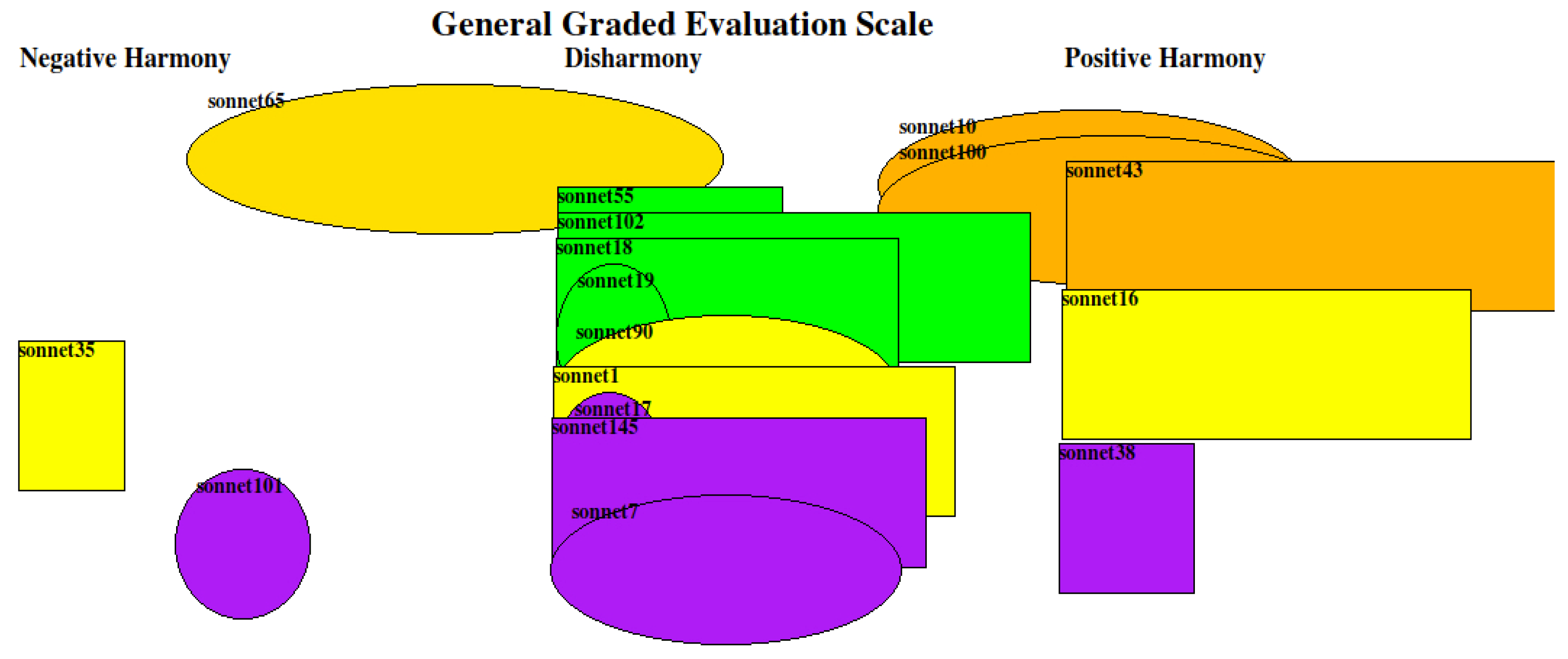
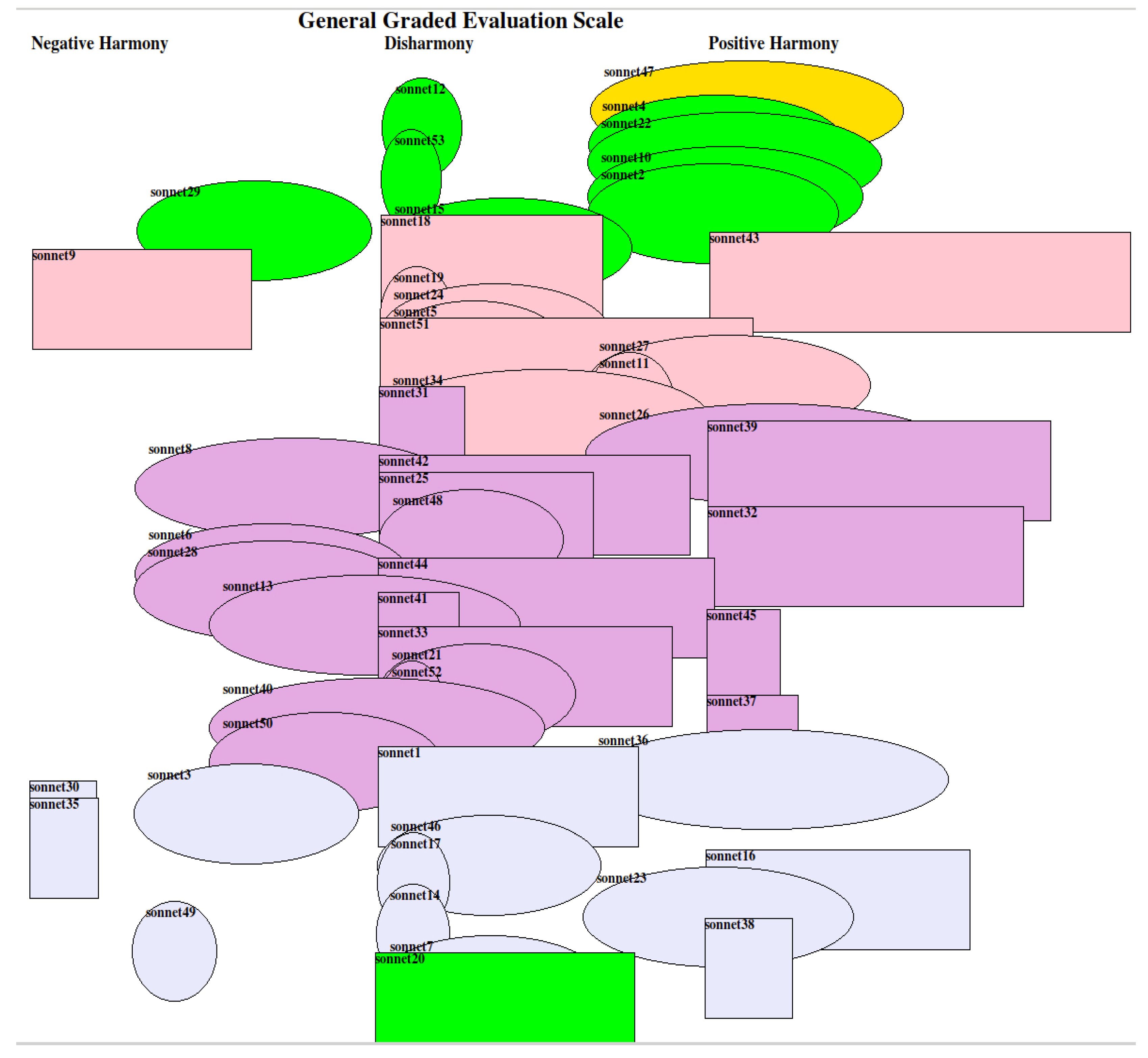
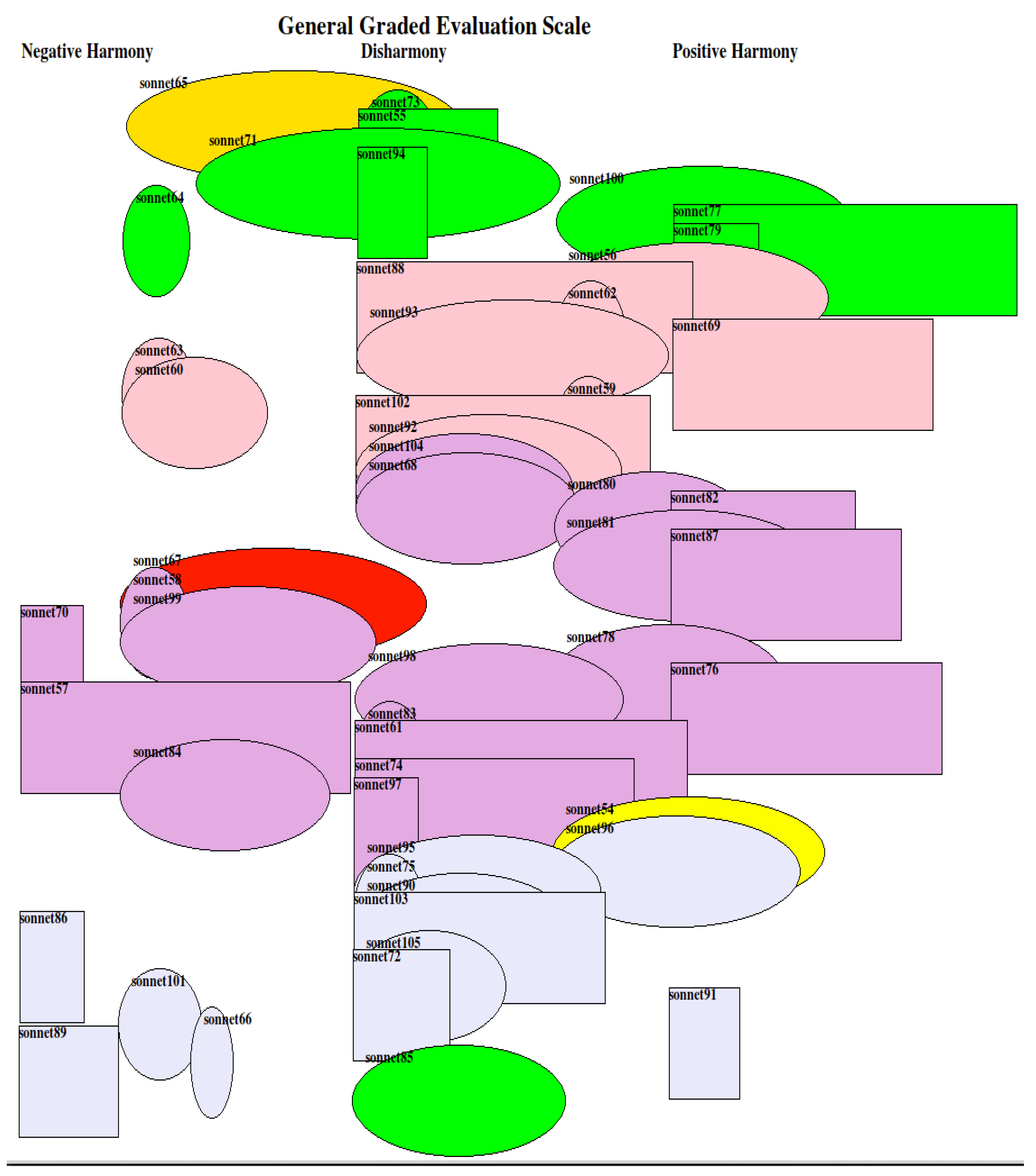
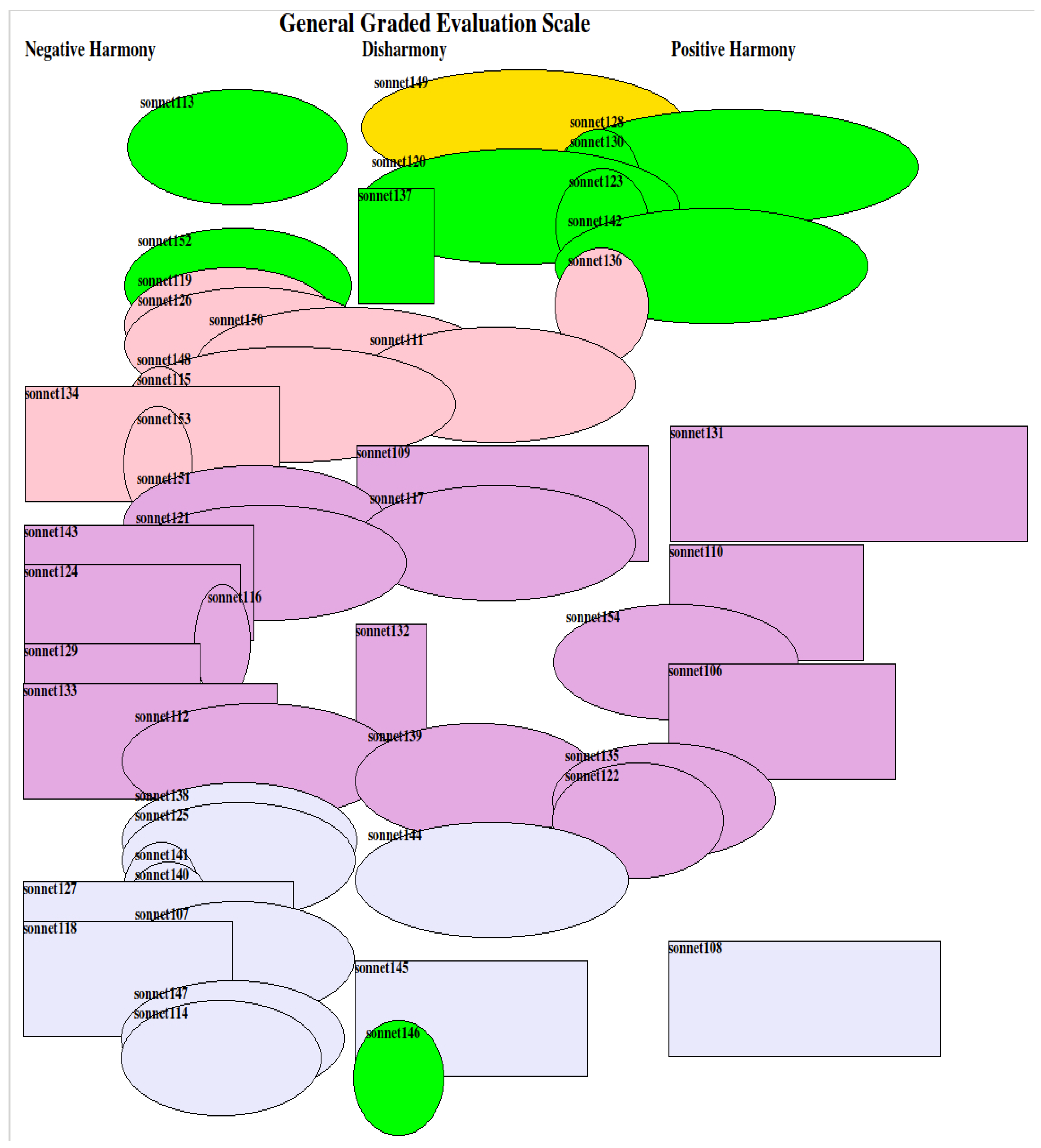

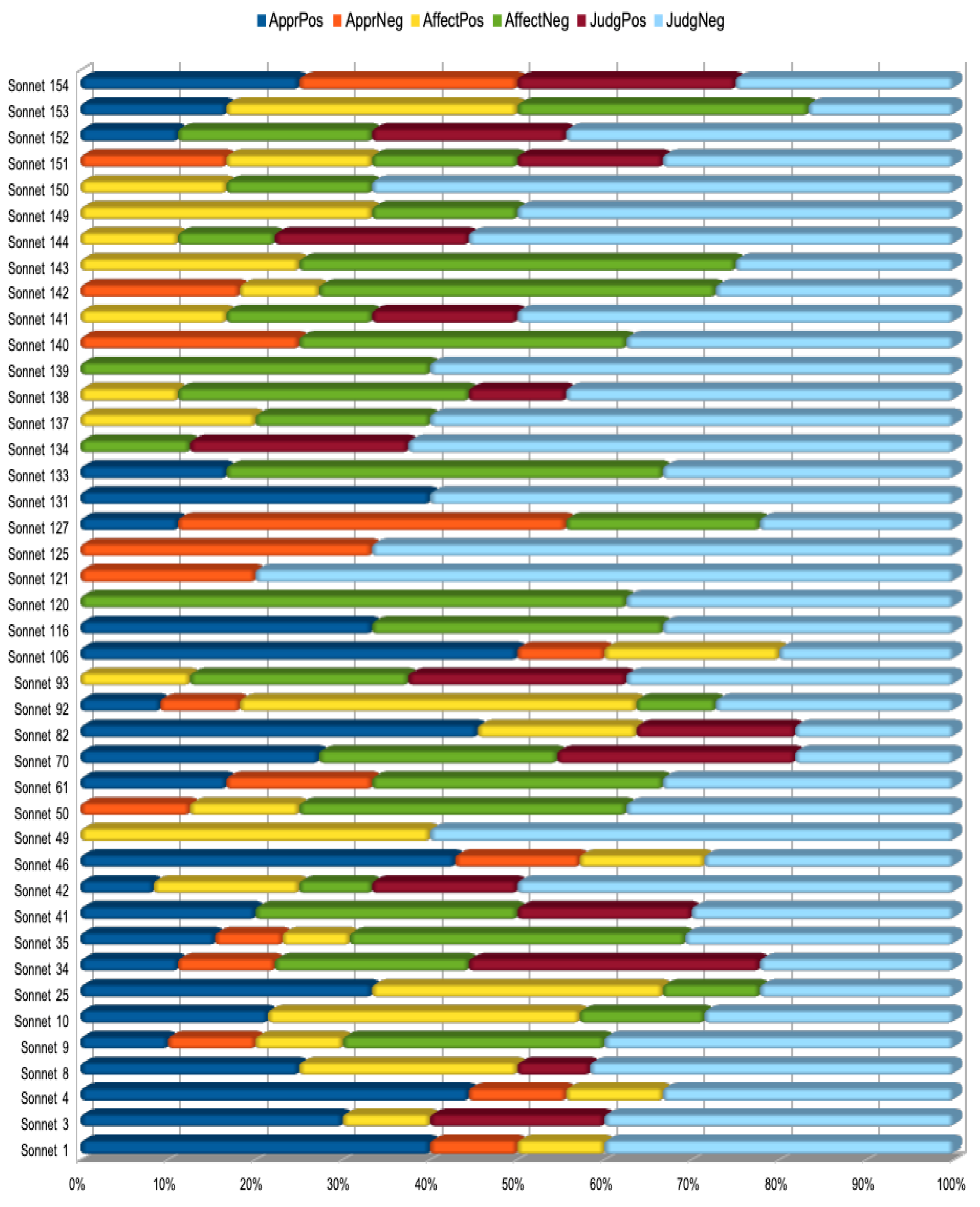

| Parameters | Sonnets 1-54 | Sonnets 55-105 | Sonnets 106-154 | Macro Averages |
| Vowels | 0.749 | 0.843 | 0.809 | 0.8 |
| Consonants | 0.379 | 0.424 | 0.39 | 0.4 |
| Voicing | 0.645 | 0.653 | 0.653 | 0.65 |
| Polarity | 1.707 | 1.684 | 1.322 | 1.6 |
| Disharmony Class/Batches |
Sonnets 1-53 |
Sonnets 54-105 |
Sonnets 106-154 |
Totals |
| Negatives | 3 | 4 | 7 | 14 |
| Disharmony Negatives |
9 | 11 | 19 | 39 |
| Positives | 7 | 7 | 4 | 18 |
| Disharmony Positives |
10 | 9 | 8 | 27 |
| Fully Disharmonic |
24 | 21 | 11 | 56 |
Disclaimer/Publisher’s Note: The statements, opinions and data contained in all publications are solely those of the individual author(s) and contributor(s) and not of MDPI and/or the editor(s). MDPI and/or the editor(s) disclaim responsibility for any injury to people or property resulting from any ideas, methods, instructions or products referred to in the content. |
© 2024 by the authors. Licensee MDPI, Basel, Switzerland. This article is an open access article distributed under the terms and conditions of the Creative Commons Attribution (CC BY) license (http://creativecommons.org/licenses/by/4.0/).





